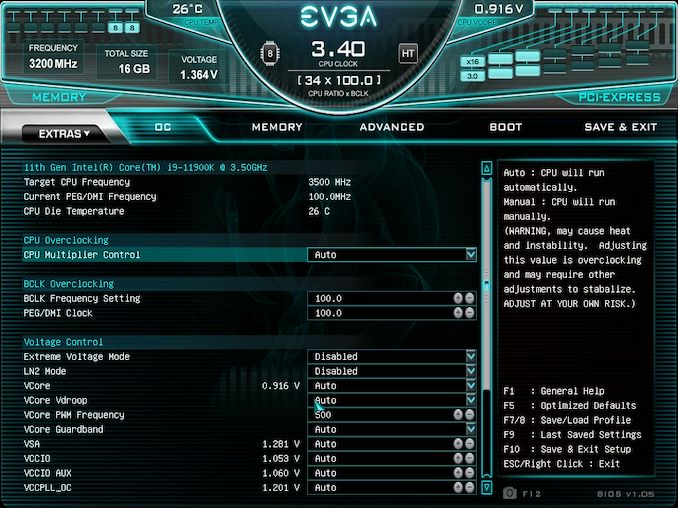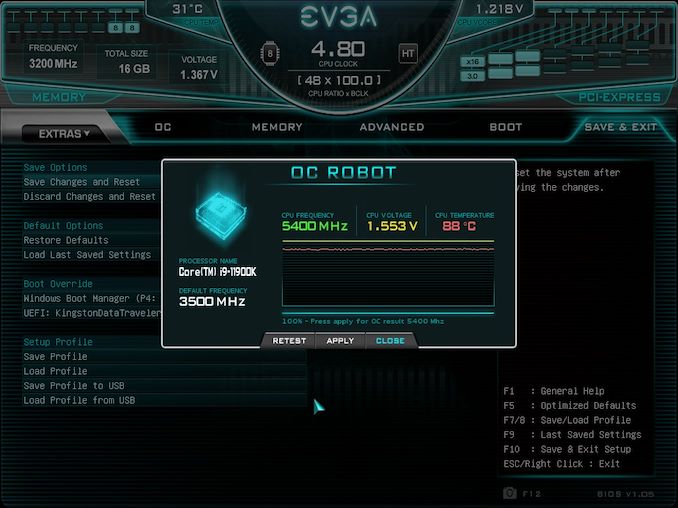The EVGA Z590 Dark Motherboard Review: For Extreme Enthusiasts
by Gavin Bonshor on October 15, 2021 9:00 AM ESTOverclocking
The skill of overclocking is one that can take thousands of hours to get to grip with the hardware, software, and then a new processor generation comes along which requires half of it to be learned again! Getting the right combination of settings to deliver an optimized yet stable enough system to deliver the performance can be time-consuming and tedious. Despite the excellent work from both Intel and AMD over the last couple of years with its interpretations of 'turbo' and 'boost,' this doesn't typically affect all of the cores equally, and instead focuses on one or two for that immediate single thread push. On an eight-core processor such as the Intel Core i9-11900K, providing whatever software of application is being used can utilize the cores and threads, typically more performance can be had from pushing all of the cores higher. At present, Intel employs some of the most aggressive methods of automatic overclocking with its Thermal Velocity Boost (TVB), and more recently with Rocket Lake, its new Adaptive Boost Technology (ABT) on its 11th Gen Core i9 K and KF processors.
Perhaps the biggest disadvantage when it comes to overclocking the processor has to deal with the extra thermal and power implications. As Intel pushes its silicon almost to its limit right out of the factory, adequate cooling is needed. Due to previous experiences when overclocking our i9-11900K in previous Z590 reviews, we've seen power consumption figures surpassing 350 W when overclocking, which is a phenomenal amount of wattage for an eight-core chip. Even at default settings, new processors from both Intel and AMD typically run warmer than previous generations. Hence, we recommend using premium cooling solutions such as AIO CPU coolers or even large tower coolers to help manage the extra heat generated. But even with that said, in a good amount of our 11th Gen CPU overclock testing, it hasn't been worth the effort. The EVGA Z590 Dark, however, is geared for overclocking so we should see typically better performance than 'standard' Z590 models.
Experience with the EVGA Z590 Dark
As the EVGA Z590 Dark is one of around five overclocking-focused motherboards on the market, a lot of the firmware is dedicated to overclocking both Intel's 11th generation processors and the attached memory. All of the board's overclocking settings can be found within the OC section. This can be accessed by selecting the Enter Setup option from the initial splash screen.
Looking at the settings available within the OC section, users can overclock both the processor and Intel's UHD integrated graphics. Users can simply overclock the processor by adjusting the CPU Multiplier on an all-core or per-core basis and changing the CPU VCore. Much of the bread and butter with the Z590 Dark is the option for extreme overclockers, which includes an LN2 mode that unlocks the CPU VCore beyond what's available in 'normal' mode, and should only be done by experienced users. There's plenty of voltage options available and users can adjust all of Intel's TVB and ABT settings for more aggressive or conservative power control.
EVGA also includes extensive memory overclocking options. This includes the ability to enable XMP 2.0 memory profiles on compatible kits, as well as customize frequency, change Intel's Geared memory mode from 1:1 to 1:20, as well as loads of latency configuration options. EVGA has included a range of memory overclocking profiles for users with high binned memory, with profiles available from both KINGPIN and Luumi, who are two of the most renowned extreme overclockers in the world.
Included as part of the firmware is the EVGA OC Robot, which is a handy tool for letting the boards overclock the processor for users. What makes this unique is that the EVGA OC Robot includes a built-in stress tester which tests each frequency and voltage variation from a lookup table. Once it has gone through the motions, it outputs an all-core CPU overclock including both what it thinks is a stable frequency and CPU VCore. Users can go to retest the settings or apply them by clicking the apply button.
Overclocking Methodology
Our overclocking methodology is as follows. We select the automatic overclock options and test for stability with POV-Ray and Prime95 to simulate high-end workloads. These stability tests aim to catch any immediate causes for memory or CPU errors.
For manual overclocks, based on the information gathered from the previous testing, start off at a nominal voltage and CPU multiplier, and the multiplier is increased until the stability tests are failed. The CPU voltage is increased gradually until the stability tests are passed. The process is repeated until the motherboard reduces the multiplier automatically (due to safety protocol) or the CPU temperature reaches a stupidly high level (105ºC+). Our testbed is not in a case, which should push overclocks higher with fresher (cooler) air.
Overclocking Results
Overclocking our Core i9-11900K provided some interesting results on the EVGA Z590 Dark motherboard. Included with the Z590 Dark are the EVGA Gamer Mode and EVGA's OC Robot which is an automatic overclocking utility. We tested both and found that the Gamer Mode provided no real benefit over the board's default settings, giving us little more than a higher power draw during POV-Ray. The EVGA OC Robot came up with an all-core CPU Frequency of 5.4 GHz with a whopping 1.541 V on the CPU VCore. These settings did run, but with massive thermal throttling, and it came close to pulling 500 W of power, which is an insane power draw for an 8-core processor.
Testing overclocks manually from 4.7 GHz and beyond, we managed to achieve an all-core stable overclock of 5.2 GHz at 1.42 V on the CPU VCore. This was a little disappointing as we have been able to achieve 5.3 GHz all-core on this processor on other overclocking-focused models we've tested, so we know it can do better. We did notice very large levels of VDroop in our testing at both 5.1 and 5.2 GHz. From 4.7 GHz to 5.0 GHz, VDroop was relatively tight, however.
Overall we would have expected to achieve at least 5.3 GHz all-cores on the EVGA Z590 Dark, but it seems the real bread and butter of this board's performance will likely be unleashed with more extreme cooling methods.













27 Comments
View All Comments
Wrs - Monday, October 18, 2021 - link
AM4 isn't that bad. AMD has a ways to catch up to Intel in architecture & support, but the Zen 3 core is great, the CCD process node is world class, and PBO is effortlessly stable. As of April 2021 the USB issues are no longer. I specifically waited till then to buy a 5800x. That's 8C, 1 CCD, comparable to RKL but at half the power. You really don't need to upgrade BIOS/AGESA unless there are issues, or you're changing the CPU/OS. Haven't heard of AM4 specific PCIe issues (shoddy riser cables are a physical thing), and WHEA errors come from unstable all-core OCs or not taking a few hours to test and tune XMP RAM, seeing as XMP is tested on Intel platforms.That said, AM4 is nearing EOL as well, just 7 or 9 months later than Z590. I view performance as effectively a toss-up between the two, but that is a painful power delta over several years of ownership.
Silver5urfer - Monday, October 18, 2021 - link
Sorry you are wrong. I've seen people reporting USB issues on OCN, Reddit, NBR and other forums. All the issues are an inherent design flaw of Ryzen. This is AMD's specific first time come back so It's kinda expected. Nobody should push their IMC part 3600MHz of 1:1 FCLK.You are parroting April because that's the AGESA 1.2.0.2 fix which did not fix anything. I read already 70 pages of the thread on OCN about initial batch issues and the new thread as well regarding WHEA, as I said. Run Zen 3 on barebone stock or don't bother if you bother the CPU will glitch out with all the issues. Period. I'm a new buyer man what should I have even an incentive for looking for all these ? because I don't want to dabble in headaches on a DIY build.
Wrs - Tuesday, October 19, 2021 - link
Idk how else to tell ya this. I actually run a 5800x, it sits on a B550 board, there's 64 GB of RAM (4 sticks) at 3600 MHz, and Fclk is 1800 MHz aka 1:1 as listed on CPU-z. I do not get USB dropouts for my mouse, keyboard, external drive, or occasional printer or thumb drive. I don't get WHEA errors when I leave HWInfo running for a few days. My average uptime (wall clock time between reboots) is 8 days 14 hours. I haven't had a bluescreen since I gave up per-core undervolting.We're in agreement that people reported USB issues. That's why I waited before buying the 5800x. I do not know if it was a design flaw or configuration error or even if my specific system needed fixing, but with AGESA 1.2.0.1 Patch A back in April (my mobo maker listed USB connectivity among the release notes) I've never had the chance to experience USB dropouts.
danny11 - Monday, October 18, 2021 - link
Unfortunately TiN is retired from EVGA. He moved to US I guess due to family. Now those nice amazing articles on Xdevs are nowhere since Z490 series. <a href="www.abcd.com">abc</a>KennethHo - Saturday, February 19, 2022 - link
Is this not a weird MB?It's a massive E-ATX board, but only has 2 usable PCIe slots and 2 DIMM slots, for $600, with OK performance.
https://jaredspears.com/
ridnout - Monday, August 1, 2022 - link
That is to accommodate NVLink with 4-slot spacing because of the size of premium 30 Series Nvidia and 6000 series AMD offerings. Blower style fans are limited as per Nvidia, so adequate spacing for cards using NVLink (think SLI on steroids) is a must for cooling the hotter 3080/90 graphics cards. For machine learning, scientific computing, CAD, video editing, and host of other professional applications that can leverage NVLink, a linked pair of 3090 will markedly outperform on most tasks a an A6000 for a fraction of the cost. Remember, the consumer cards won't do high precision...limitations of the drivers.Just 2 cents.
haileynelson10 - Wednesday, April 13, 2022 - link
Appreciate detailed reviews for EVGA Z590 Dark Motherboard. I still have some doubts but this post solves it.https://findaword.co/